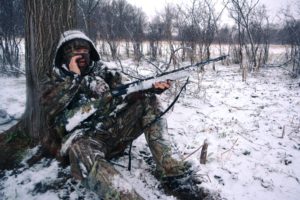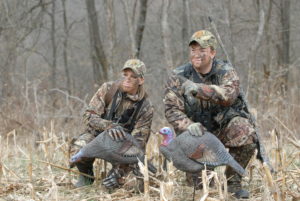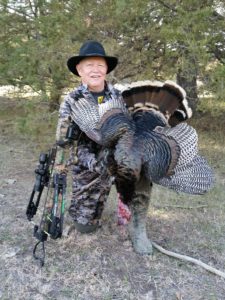This week, The Hunting Page brought you a report in which one member of a hunting party shot one of his buddies in a “fanning” incident. Unfortunately, a similar problem occurred shortly there after, this one caught on video. With a million turkey hunters afield, two incidences don’t make an epidemic, yet even one accidental shooting is way too many. Before getting to the video of this post from FB page, I love to Hunt, consider these six safety tips to make sure you don’t put yourself or others in harm’s way:

Set Up Safely– When calling to or luring a gobbler toward your location, consider that another hunter may be neary. Don’t sit by logging roads or other places of likely hunter travel. Call the bird into an open area where you an see it clearly. Turkeys rarely approach through thick brush, making this an effective hunting strategy as well. Sit with your back against a large tree or other obstruction as a precaution against what you can’t see.
Avoid Target Colors- Never wear red, white, or blue when hunting or in the field during turkey season. I was hunting mushrooms yesterday and took off my blue and white flannel shirt as a safety measure. Also, because I have white hair, I wore a hat for extra precaution. As I walked along a logging road, I saw a flash of red and thought it to be a gobbler’s head. In a few seconds, a cardinal popped up which leads to the next topic.
Be Sure of Your Target- The proper way to kill a spring gobbler with a shotgun is to lure it to 30 yards or closer and make a “putt” sound with a diaphragm caller. The bird will extend its neck and BOOM. In this scenario, all of the shot goes into the head and neck, killing the bird instantly and ruining no meat. Body shooting a turkey is rarely successful, ruins the meat, and can lead to mistaken identity. As with my cardinal experience, make sure you can identify your target clearly and have an ethical probability of killing it.

Use decoys with utmost care- I often hunt with a crossbow and use decoys as part of my hunting strategy. A gobbler will often approach a decoy closer and become preoccupied while I raise my bow. If you use decoys, carry them in a camouflaged bag or the back pocket of your turkey vest, yet be sure that the head (especially of a jake) is not visible. When you position a decoy, consider the advance of another hunter. Would you be in the line of fire if he mistook your decoys for real birds?

Never Stalk a Turkey- Spot-and-stalk turkey hunting can be done safely in the Great Plains or other areas with expansive visibility. However, in the forested East and South, doing so is very dangerous and illegal in Pennsylvania. A gobbling turkey does crazy things to a hunter’s imagination and you could be mistaken for a moving tom.
Consider Using Blaze Orange- Blaze orange is problematic for spring hunters because turkeys can see color. Pennsylvania law requires a hunter to wear blaze orange while moving and to post it near a calling site. Although unpopular with hunters in general, this practice may have prevented both accidents.
Hunting is one of America’s safest sports, thanks to Hunter Safety Courses, effective law enforcement by conservation officers, and an overall positive public attitude toward safety. Enjoy the excitement of the spring season, yet think safety before success.









![The Best Deer Camp Chili [VIDEO] Deer Chili Ingredients, Tomatoes, Chili Spices](/wp-content/uploads/2015/10/Deer-Chili-Deer-Camp-Recipe-218x150.jpg)








![How to Call Elk Early in the Season [VIDEO]](/wp-content/uploads/2016/08/byers003-218x150.jpg)




![Idiots Disturb Hunter: How Would You Have Handled It? [VIDEO]](/wp-content/uploads/2015/10/DSC00110-e1474487693878-100x70.jpg)
![Albino Buck Shocked to Shed His Antlers [VIDEO]](/wp-content/uploads/2015/10/AlbinoDeer-100x70.jpg)